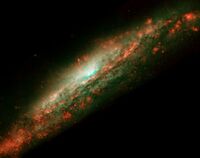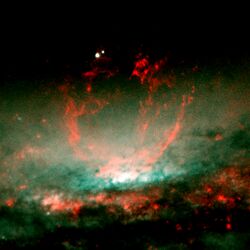Astronomy:NGC 3079
| NGC 3079 | |
|---|---|
 A Hubble Space Telescope (HST) image of NGC 3079. | |
| Observation data (J2000 epoch) | |
| Constellation | Ursa Major |
| Right ascension | 10h 01m 57.8s[1] |
| Declination | +55° 40′ 47″[1] |
| Redshift | 1116 ± 1 km/s[1] |
| Distance | 50 Mly[2] |
| Apparent magnitude (V) | 11.5[1] |
| Characteristics | |
| Type | SB(s)c[1] |
| Apparent size (V) | 7.9′ × 1.4′[1] |
| Other designations | |
| UGC 5387,[1] 4C 55.19, PGC 29050[1] | |
NGC 3079 is a barred spiral galaxy about 50 million light-years away, and located in the constellation Ursa Major. A prominent feature of this galaxy is the "bubble" forming in the very center (see picture below). The supermassive black hole at the core has a mass of 2.4+2.4
−1.2×106 M☉.[3]
Two supernovae have been observed in NGC 3079: SN 2001ci (type Ic, mag. 18.3),[4] and SN 2013ee (type II, mag. 15.5).[5]
Center Bubble
The bubble forming in the center of NGC 3079 is believed to be about 3000 light-years wide and to rise more than 3500 light-years above the disc of the galaxy. It is speculated that the bubble is being formed by particles streaming at high speeds, which were in turn caused by a large burst of star formation. This current bubble is thought to have been created about one million years ago, and computer modeling suggests that there is an ongoing cycle of forming bubbles, with a new bubble forming approximately every 10 million years.
See also
References
- ↑ 1.0 1.1 1.2 1.3 1.4 1.5 1.6 1.7 "NASA/IPAC Extragalactic Database". Results for NGC 3079. http://nedwww.ipac.caltech.edu/.
- ↑ "Burst of Star Formation Drives Bubble in Galaxy's Core - Fast Facts". http://hubblesite.org/newscenter/archive/releases/2001/28/fastfacts/.
- ↑ Graham, Alister W. (November 2008), "Populating the Galaxy Velocity Dispersion - Supermassive Black Hole Mass Diagram: A Catalogue of (Mbh, σ) Values", Publications of the Astronomical Society of Australia 25 (4): 167–175, doi:10.1071/AS08013, Bibcode: 2008PASA...25..167G.
- ↑ Transient Name Server entry for SN 2001ci. Retrieved 31 March 2023.
- ↑ Transient Name Server entry for SN 2013ee. Retrieved 31 March 2023.
External links
- HST: Burst of Star Formation Drives Bubble in Galaxy's Core
- Superwind Sculpts Filamentary Features - Chandra X-ray Observatory
- NASA Astronomy Picture of the Day: The Bubbling Cauldron of NGC 3079 (22 August 2001)
 |


